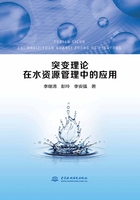
参考文献
[1] Cobb L,Watson B.Statistical catastrophe theory:An overvies[J].Mathematical Modeling,1980,1(4):311-317.
[2] Cobb L.Estimation theory for the cusp catastrophe model[C]//Proceedings of the American Statistical Association Section on Survey Research Methods,1980:772-776.
[3] Cobb L,Zacks S.Applications of catastrophe theory for statistical modeling in the biosciences
[J].Journal of the American Statistical Association,1985,80(392):793-802.
[4] Glukhova S I,Palkin E A.Application of catastrophe theory for multimodal distributions statistical analysis[J].Theory Probab.Appl.,2005,49(3):414-428.
[5] Wagenmakers E J,Molenaar C M P,et al.Transformation invariant stochastic catastrophe theory[J].Physica D:Nonlinear Phenomena,2005,211(3-4):263-276.
[6] M V Berry.Waves and Thom’s theorem[J].Advances in Physics,1976,25(1):1-26.
[7] P J Holmes,D A Rand.The bifurcations of Duffing’s equation:an application of catastrophe theory[J].Journal of Sound and Vibration,1976,44(2):237-253.
[8] E C Zeeman.Duffing’s equation in brain modelling[J].Bull.Inst.Math.Appl., 1976(7):207-214.
[9] Zeeman E C.Euler Buckling[J].Lecture Notes in Mathematics,1976(525):373-395.
[10] T Poston,I N Stewart.Catastrophe Theory and Its Applications[M].Pitman,London,1978.
[11] R Ito.Application of Catastrophe Theory to the Breakup of a Liquid Drop in a Shear Field[J].Int.Chem.Engng.,1980,20(2):266-271.
[12] Marco Carricato,Joseph Duffy,Vincenzo Parenti-castelli.Catastrophe Analysis of a Planar System with Flexural Pivots[J].Mechanism and Machine Theory,2002,37(7):693-716.
[13] J E García-Ramos,J M Arias,J Dukelsky.Disentangling phase transitions and critical points in the proton-neutron interacting boson model by catastrophe theory[J].Physics Letters B,2014(736):333-338.
[14] S C Tripathy.Transient stability analysis of multimachine power system using swallowtail catastrophe model[J].Energy Conversion and Management,1998,39(12):1247-1253.
[15] Venkataramana Ajjarapu.Application of Catastrophe Theory to Describe Voltage Collapsein Power Systems[C]//Circuits and Systems.Proceedings of the 32nd Midwest Symposium on,Ieee,1989:248-251.
[16] R Parsi-feraidoonian,Xianlin Sun,M D W Vong.Catastrophe Theory Model of Multimachine Power Systems for Transient Stability Studies[C]//Tencon’93.Computer,Communication,Control and Power Engineering,1993:187-190.
[17] Bertola V,Cafaro E.Deterministic - stochastic approach to compartment fire modeling[J].Mathematical,Physical and Engineering Sciences,2009,465(2104):1029-1041.
[18] Quintiere J G,Steckler K,Corley D.An assessment of fire induced flows in compartments[J].Journal of Fire Sciences,2001,19(6):413-427.
[19] Ma Z S,Bechinski E J.An approach to the nonlinear dynamics of Russian wheat aphid population growth with the cusp catastrophe model[J].Entomological Research,2009,39(3):175-181.
[20] M K D K Piyaratne,Huiyan Zhao,Qingxiang Meng.APHIDSim:A population dynamics model for wheat aphids based on swallowtail catastrophe theory[J].Ecological Modelling,2013(253):9-16.
[21] E C Zeeman.Catastrophe Theory[J].Scientific American,1976(234):65 - 83.
[22] Zeeman E C.Brain Modelling[M].Springer Berlin Heidelberg,1976.
[23] Henley S.Catastrophe theory models in geology[J].Journal of the International Association for Mathematical Geology,1976,8(6):649-655.
[24] M C John,S Brain.The geological implication of steady-state mechanism in catastrophe theory[J].Mathematical Geology,1976,8(6):657-662.
[25] Dendrinos D S.Operating speeds and volume to capacity ratios:The observed relationship and the fold catastrophe[J].Transportation Research,1978,12(3):191-194.
[26] Navin F P D.Traffic congestion catastrophes[J].Transportation Planning and Technology,1986,11(1):19-25.
[27] Ghorbani M A,Khatibi R,Sivakumar B,et al.Study of discontinuities in hydrological data using catastrophe theory[J].Hydrol.Sci.J.,2010,55(7):1137-1151.
[28] Alaa M Al-Abadi,Shamsuddin Shahid.A comparison between index of entropy and catastrophe theory methods for mapping groundwater potential in an arid region[J].Environmental Monitoring and Assessment,2015(187):576.
[29] Sadeghfam S,Hassanzadeh Y,Nadiri A A,et al.Localization of Groundwater Vulnerability Assessment Using Catastrophe Theory[J].Water Resour Manage,2016(30):4585.
[30] Al-Abadi A M,Shahid S,Al-Ali A K.A GIS-based integration of catastrophe theory and analytical hierarchy process for mapping flood susceptibility:a case study of Teeb area,Southern Iraq[J].Environ Earth Sci.,2016(75):687.
[31] Blum E H,Mehra R K.Chemical kinetics and catastrophe theory[R].I.I.A.S.A.Report,1975.
[32] Mehra R K,Blum E H.On the dynamics of the ignition of paper and catastrophe theory[R].I.I.A.S.A.Report,1975.
[33] E C Zeeman.Primary and secondary waves in developmental biology[C]//Some Mathematical Questions in Biology Ⅷ.Lectures in Mathematics in the Life Sciences,1974:69-161.
[34] M J Bazin,P T Saunders.An application of catastrophe theory to the study of a switch in Dictyostelium discoideum[C]//Kinetic Logic-A Boolean Approach to the Analysis of Complex Regulatory Systems,Berlin:Springer,1979.
[35] Priya Ranjan,Eyad H Abed,Richard J La.Nonlinear Instabilities in TCP-RED[J].Networking,IEEE/ACM Transactions on,2004,12(6):1079-1092.
[36] Luc Florack,Arjan Kuijper.The Topological Structure of Scale-space Images[J].Journal of Mathematical Imaging and Vision,2000,12(1):65-79.
[37] J Barkley Rosser.The rise and fall of catastrophe theory applications in economics:Was the baby thrown out with the bathwater?[J].Journal of Economic Dynamics and Control,2007,31(10):3255-3280.
[38] Al-Abadi A M,Shahid S,Al-Ali A K.A GIS-based integration of catastrophe theory and analytical hierarchy process for mapping flood susceptibility:a case study of Teeb area,Southern Iraq[J].Environ Earth Sci.,2016(75):687.
[39] 桑博德.突变理论入门[M].凌复华,译.上海:上海科学技术文献出版社,1983.
[40] 刘春艳,运如婷,冯国良.基于突变理论的洪灾风险评估[J].才智,2011(7):68.
[41] 李晋辉,黄金池,何晓燕,等.基于突变理论的山洪灾害风险评价指标体系构建与应用[J].水利水电技术,2015,46(12):129-132.
[42] 李绍飞,冯平,孙书洪.突变理论在蓄滞洪区洪灾风险评价中的应用[J].自然灾害学报,2010,19(3):132-138.
[43] 苏超,万玉文,方崇,等.突变理论在城市防洪体系综合评价中的应用[J].中国防汛抗旱,2011,21(4):46-49.
[44] 高玉琴,吴靖靖,胡永光,等.基于突变理论的区域洪灾脆弱性评价[J].水利水运工程学报,2018(1):32-40.
[45] 王德维.基于突变理论的水资源开发利用风险评价[C]//河海大学,中国水利经济研究会,黑龙江省水利科学研究院.2017中国水资源高效利用与节水技术论坛论文集,2017:6.
[46] 黄奕龙,董志颖,杨建强.流域水资源丰富度评价的突变评判模型[J].国土与自然资源研究,2001(1):15-17.
[47] 牛文娟,王伟伟,戴传阳,等.跨界流域水资源冲突的脆性与评价[J].水利经济,2017,35(6):59-65,81-82.
[48] 王巍巍.突变理论在大型灌区水资源利用综合评估中的应用[J].水利规划与设计,2016(11):44-45,51.
[49] 王红旗,侯泽青,秦成.基于突变理论的泉州市水资源安全预警[J].南水北调与水利科技,2012,10(5):1-6.
[50] 李三平,徐强.突变理论及PLS模型在城市缺水程度评价中的应用[J].中国新技术新产品,2012(21):4.
[51] 李绍飞,孙书洪,王向余.突变理论在海河流域地下水环境风险评价中的应用[J].水利学报,2007,38(11):1312-1317.
[52] 栾元重,姜岩.地下水动态的突变预测模型[J].水文地质工程地质,1991,18(4):16-18.
[53] 都吉龙.基于突变理论的区域地下水资源开采阈值研究[J].水资源开发与管理,2017(9):30-33.
[54] 徐明峰,李绪谦,金春花,等.尖点突变模型在地下水特殊脆弱性评价中的应用[J].水资源保护,2005,21(5):19-22.
[55] 冶雪艳,赵坤,杜新强,等.突变理论在地下水开发风险评价中的应用研究[J].人民黄河,2007,29(10):47-48,50.
[56] 陈云峰,殷福才,陆根法.水华爆发的突变模型——以巢湖为例[J].生态学报,2006,26(3):878-883.
[57] 李艳,陈晓宏,张鹏飞.突变级数法在区域生态系统健康评价中的应用[J].中国人口·资源与环境,2007,97(3):50-54.
[58] 郑德凤,臧正,苏琳.基于突变级数法的吉林省生态补偿标准核算[J].生态与农村环境学报,2013,29(4):537-540.
[59] 崔巍.河流健康突变级数模型探析[J].水利规划与设计,2017(6):58-60.
[60] 汤洁,刘岩岩,王博,等.基于突变基数法的辽河重污染支流生态安全研究[J].水土保持研究,2014,21(3):251-255.
[61] 孙雪峰,于莲.水生态系统的突变模型[J].水科学与工程技术,2007(1):39-41.
[62] 魏婷,朱晓东,李杨帆,等.突变级数法在厦门城市生态安全评价中的应用[J].应用生态学报,2008,19(7):1522-1528.
[63] 王辉,陈法兴,陆健刚.基于突变理论的近岸海域富营养化程度研究[J].人民黄河,2017,39(7):100-103,109.
[64] 吕爽,齐青青,张泽中,等.基于突变理论的城市河流生态健康评价研究[J].人民黄河,2017,39(4):78-81.
[65] 吴颖超,王震,曹磊,等.基于突变级数法的徐州市近10年水环境承载力评价[J].水土保持通报,2015,35(2):231-235.
[66] 李美香,周向华,王启明,等.基于改进突变级数法的秦淮河河流健康评价[J].水资源与水工程学报,2016,27(6):39-43.
[67] 李亚男.突变理论在湖库生态安全评价中的应用探讨[C]//中国环境科学学会.2017中国环境科学学会科学与技术年会论文集(第一卷),2017:5.
[68] 张玉山,李继清,梅艳艳,等.基于突变理论的天津市水资源安全阈值分析模型[J].辽宁工程技术大学学报(自然科学版),2013,32(4):562-567.
[69] 牛志广,姜巍,陆仁强,等.基于突变理论的城市配水系统脆弱性评价模型[J].哈尔滨工业大学学报,2012,44(10):135-138.
[70] 任珩,赵成章,安丽涓.基于突变级数法的民勤绿洲水资源管理政策绩效评价[J].资源科学,2014,36(5):922-928.
[71] 顾冲时,吴中如,徐志英.用突变理论分析大坝及岩基稳定性的探讨[J].水利学报,1998,29(9):48-51.
[72] 邓跃进,董兆伟,张正禄.大坝变形失稳的尖点突变模型[J].武汉测绘科技大学学报,1999,24(2):170-173.
[73] 李雪红,顾冲时,赵斌.大坝裂缝的突变模型研究[J].水电能源科学,2000,18(4):16-18.
[74] 李凤珍.基于变形的拱坝坝肩稳定分析方法研究[D].南京:河海大学,2007.
[75] 傅蜀燕,黄海燕,欧正蜂.基于尖点突变模型的水库工程脆弱性分析[J].人民珠江,2017,38(5):70-72.
[76] 李乾德,王东,谢鑫,等.基于突变级数法的陈蔡水库安全综合评价[J].水力发电,2017,43(2):114-117.
[77] 何金平,李珍照.基于突变理论的大坝安全动态模糊综合分析与评判[J].系统工程,1997(5):39-43.
[78] 谷艳昌,王士军.水库大坝结构失稳突发事件预警阈值研究[J].水利学报,2009,40(12):1467-1472.
[79] 陈迪辉,包腾飞,金盛杰,等.基于尖点突变理论的拱坝安全性分析[J].三峡大学学报(自然科学版),2018,40(1):25-28.
[80] 龙辉,秦四清,万志清.降雨触发滑坡的尖点突变模型[J].岩石力学与工程学报,2002,21(4):502-508.
[81] 安玉华,王清,张晨,等.基于突变模型的泥石流危险度评价[J].吉林大学学报(地球科学版),2012,42(S1):355-361.
[82] 栾婷婷,吕则恺,马政,等.基于安全流变-突变理论的排土场滑坡预警指标体系构建研究[J].北京石油化工学院学报,2017,25(3):38-42.
[83] 孙强,刘天霸,秦四清,等.斜坡失稳的燕尾突变模型[J].工程地质学报,2006,14(6):852-855.
[84] 刘炜,陈剑平,占洁伟.基于突变理论的清香坪泥石流沟危险性评价[J].人民长江,2016,47(S1):100-103.
[85] 王志强,韩金生,潘岳.水库诱发地震的折叠突变模型[J].中国矿业大学学报,2010,39(3):368-372,385.
[86] 刘鼎文.突变理论在地震成因及地震危险性与岩体稳定性评价研究中的应用[J].国际地震动态,1991(3):35-36.
[87] 王小亭.突变理论在企业管理中的应用探讨[J].上海机械学院学报,1989(4):79-84.
[88] 黄长征.期货市场投机者粘性预期的尖点突变模型[J].五邑大学学报(自然科学版),2000,14(1):1-6.
[89] 李翔.股市行情波动的突变学模型与分析[J].预测,1994(4):33-35.
[90] 邹坦,周鹏,周波.工程项目突变投资决策模型[J].南方冶金学院学报,1997,18(1):57-62,69.
[91] 李一智,侯晓鸿,刘咏梅,等.期货价格突变论模型的建立和分析[J].中南工业大学学报(社会科学版),1999(1):15-18.
[92] 唐铁桥,黄海军.用燕尾突变理论来讨论交通流预测[J].数学研究,2005,38(1):112-116.
[93] 张亚平,张起森.尖点突变理论在交通流预测中的应用[J].系统工程学报,2000,15(3):272-276.
[94] 胡建荣,何磊.基于尖点突变理论的高速公路交通流状态判别方法[J].中国公路学报,2017,30(10):137-144.
[95] 徐阳,张多加,胡大伟.突变理论在交通流分析中的应用[J].自动化与仪器仪表,2017(7):171-173.
[96] 宋守信,段晓红,赵建东.基于突变理论的地铁车站大客流脆弱性评价[J].武汉理工大学学报(信息与管理工程版),2017,39(2):125-129.
[97] 何显慈.交通流的突变模型[J].长沙交通学院学报,1986,2(2):81-85.
[98] 吴次芳,华楠.多目标突变决策方法及其在土地利用总体规划中的应用[J].农业工程学报,1996,12(2):11-16.
[99] 陈蓓鸽,徐功仁.突变理论在产业经济发展中的应用[J].华东化工学院学报,1988(S1):71-76.
[100] 魏雪莲,赵惠燕,刘光祖,等.害虫种群动态模型的燕尾突变分析[J].生态学报,2009,29(10):5478-5484.
[101] 赵惠燕.利用尖角突变模型确定病虫害发生的趋势及防治对策的研究[J].陕西气象,1992(3):28-30.
[102] 闫志刚,李俊清,孙立.基于椭圆脐点突变模型的大熊猫生存状态研究[J].生态学报,2018(13):1-13.
[103] 黄慎,黄茂钧,周平.矿柱的突变失稳研究[J].有色金属(矿山部分),2018,70(2):15-17,22.
[104] 翟文宝,李军,周英操,等.突变理论在页岩储层可压性评价中的应用[J].断块油气田,2018,25(1):76-79.
[105] 谢学斌,邓融宁,董宪久,等.基于突变和流变理论的采空区群系统稳定性[J].岩土力学,2018(6):1-11.
[106] 马爱群,李秉和,李淳飞.突变理论和光学双稳性[J].佳木斯教育学院学报,1988(4):36-53.
[107] 沈茂山,魏德敏.弹性拱振动失稳的突变模型[J].应用数学和力学,1990,11(12):1099-1102.
[108] 陈亮.应用突变理论分析Euler压杆的稳定性[J].应用力学学报,2003,20(2):111-115.